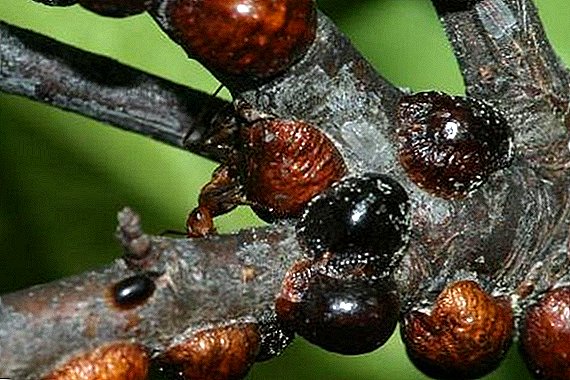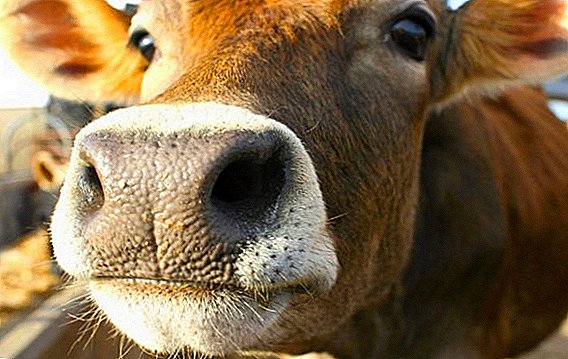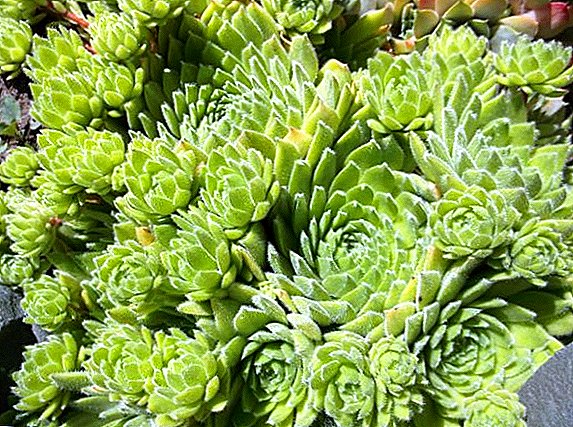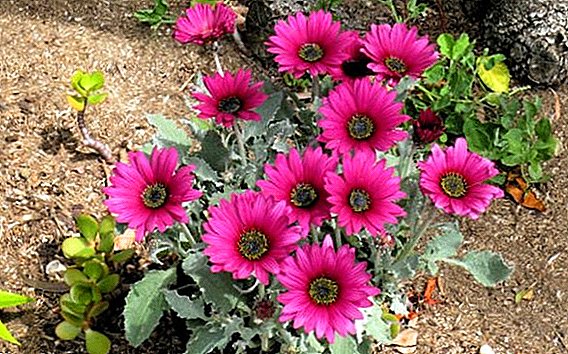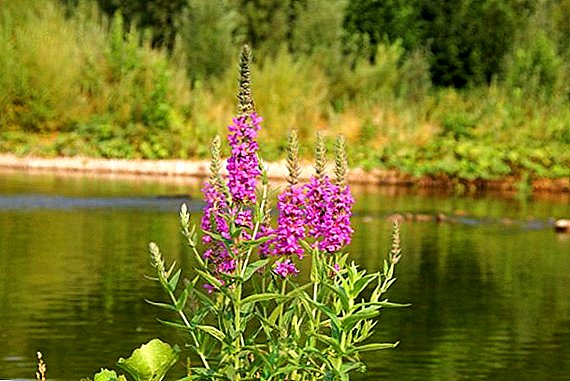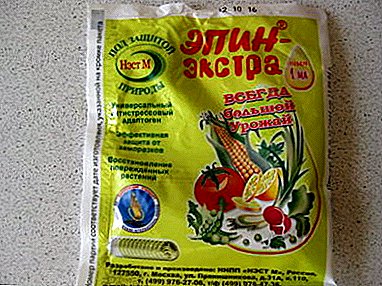 It is sometimes difficult for beginning gardeners and gardeners to decide on the variety of vegetables that would have the most favorable indicators — high yields, disease resistance and unpretentiousness to weather conditions. In this article, we will consider the variety of tomato with the romantic name Earthly Love. Characteristics of the variety, yield indicators, as well as the specifics of cultivation - in more detail in the article.
It is sometimes difficult for beginning gardeners and gardeners to decide on the variety of vegetables that would have the most favorable indicators — high yields, disease resistance and unpretentiousness to weather conditions. In this article, we will consider the variety of tomato with the romantic name Earthly Love. Characteristics of the variety, yield indicators, as well as the specifics of cultivation - in more detail in the article.
Variety description
This variety belongs to the species of shtambovy plants - a group of small and strong tomatoes belonging to the family of Solanaceae. The appearance of such plants is compact: an underdeveloped root system, the absence of large lateral branches, short stature and the presence of large fruits.
Earthly love is an early variety of tomato that fully forms the fruits by 95 days from the moment of planting.
The variety has such characteristic external features:
- fruits - large, juicy, saturated dark red color, without a green base, rounded shape, have a rather dense fleshy part with a pleasant, slightly sweetish taste;
- plant - up to 120 cm tall, abundant, compact, does not have wide spreading branches;
- leaf - medium size, dark, rough;
- stem - low, dodging, branching;
- inflorescence - simple, with a shortened axis.

Check out the description and nuances of growing tomato varieties such as "Little Red Riding Hood", "Riddle", "Masha F1 Doll", "Gina", "Aphrodite f1", "Labrador", "Samara", "Bokele F1", "Kiss geraniums, Lyubasha, Kaspar, King of the Early, Alsou, Skorospelka, Aelita Sanka, Big Mommy, Bokele, Ladies' Fingers.
The positive properties of the variety include:
- unpretentiousness;
- excellent taste;
- early formation and ripening of fruits;
- resistance to temperature extremes;
- large dense fruit that is ideal for transportation or salting for the winter;
- excellent product quality;
- fast and friendly ovary.
But the disadvantages of the variety Earthy Love include a relatively low yield - up to 6 kg from one bush. Therefore, the cultivation of this variety is irrelevant on a large industrial scale. 
In addition, the negative properties of tomato are:
- The fragility, fragility of the stem and the need for tying;
- the need for additional feeding during the vegetative period;
- not suitable for outdoor cultivation.
Despite the presence of such shortcomings and the fact that the variety appeared relatively recently (it was bred by Russian specialists in 2009), it is quite popular. Today it is grown in greenhouses not only in Russia, but also in Ukraine, Belarus, Moldova and parts of Western Europe.
We advise you to get acquainted with the best varieties of sweet, early, high-yielding, short growing and resistant to late blight tomatoes.
Such a widespread tomato was due to its early ripeness - its distinctive features and the main characteristics.
The variety copes with the task of getting the harvest as early as possible - during this period the cost of vegetables on the market is very high, and this variety, due to its taste and early ripeness, is competitive. 
Did you know? Fruits of a tomato, from the point of view of botany, belong to polygamous berries. Due to the fact that in English there is no distinctive nuance between the terms "fruit" and "fruit", tomatoes in America have long been called fruit. It was only at the end of the 19th century that the highest state body of the country, the Supreme Court, recognized that tomatoes are vegetables, because they are served not for dessert, but for lunch (although it was emphasized that in botany tomatoes are considered berries): from that moment customs the duty of tomatoes began to be charged as vegetables, not fruits.
Fruit characteristics and yield
The rapid maturation of the fruits of the variety Love Earth is possible only in greenhouse conditions, and on the open ground - only in the southern regions (Crimea, the Caucasus, etc.). In countries with a temperate climate, cultivation is possible only in film greenhouses. 
Below are the provisions that you need to know when growing this tomato:
- yield: even with excellent care, only up to 6-7 kg;
- ripening time: after 95-100 days from the date of disembarkation;
- fruit size: medium, up to 250 g, up to 6 cm in diameter, all fruits have, as a rule, the same shape and size - this increases their popularity among other varieties of tomatoes;
- Transportability: excellent, ripe fruit does not crack, has a dense skin that does not leave dents with a slight pressure;
- method of use: well suited for harvesting for the winter period, when salting, canning and pickling the fruit does not fall apart, keeps its shape well, is also used fresh in various salads, stews and casseroles.
Despite early ripening, tomatoes manage to absorb the maximum of useful substances: the chemical composition of tomato fruits contains vitamins of groups B, D, C, macronutrients (calcium, magnesium, sodium, phosphorus), trace elements (manganese, molybdenum, iron, iodine), sugar and starch. 
Selection of seedlings
In order to get a good harvest, you need to carefully consider the selection of the seedlings themselves: almost 70% of the fruit grown depends on how good the seedlings are.
What you need to know when choosing and buying seedlings of this variety:
- Purchase time - until mid-May. At a later date, flowers and ovaries will appear on the seedlings - during this period they cannot be planted.
- Remember: seedlings with flowers, and even more with the ovary, are not suitable for replanting. If for some reason you had to buy seedlings with flowering, you must remove the flowers before planting in the soil.
- Seedling age - up to 30 days.
- The stem should be quite strong and durable (no less than the thickness of the pencil). The leaves should be without damage, uniform and saturated color, the root system - well-formed, without damage and rot, but not too thick.
- Ideal seedling Love Earth - is a small (up to 10 cm) seedlings with a strong stem, 5-8 leaves and without ovary.
Carefully inspect the seedling when buying: if there are mold on the roots, rot, mechanical damage - this seedling is definitely not worth buying. Do not forget to check the seedling for the presence of eggs of pests: if the leaf is sluggish, deformed, wrinkled, and there are dark spots on the stem, this is the first sign of the presence of an infectious disease in a plant.
If you have noticed any sign of a seedling disease, it is better not to take other seedlings from this seller: most likely, the rest of the seedlings will also be infected.
Important! Sometimes gardeners use a large amount of nitrogen fertilizers to grow a seedling - this allows you to significantly accelerate the growth of seedlings and win competition in the market. However, such saturation of the plant with a chemical substance adversely affects the taste and chemical composition of the future crop. Be careful: too green shiny leaves of seedlings that curl down are indicators of such fertilizer with nitrogen.

To be completely confident in the quality of seedlings, it is better to grow it yourself. In all other cases, buy seedlings only from trusted vendors who can provide comprehensive information on all your questions.
Remember: seedlings are short-lived goods, so the merchant is interested in selling them as quickly as possible. Be careful when choosing a plant, do not hesitate to carefully examine the seedlings and ask questions about the variety, the time of planting, the conditions under which the seedlings were grown, etc.
Growing conditions
As already mentioned, this variety is suitable for cultivation, mainly in greenhouses.
For a tomato, the following conditions are required:
- Temperature. Optimum performance for rapid growth should be within + 18-20 ° C. Remember that on a sunny day, the temperature in the film greenhouse is 12-15 degrees higher than outside, and on cloudy - 4-7 degrees.
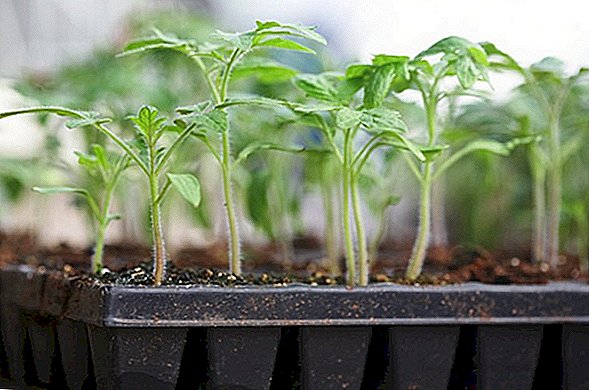 It is very important to take into account when growing tomatoes: severe overheating is just as destructive for them as frost, so on hot days it is necessary to ventilate the greenhouse by briefly removing the film. The polyethylene film cover is characterized by high permeability to heat rays, so at night in the greenhouses there is a strong decrease in temperature - at night the difference with the figures in the street is no more than 2 degrees. Therefore, at particularly low temperatures, the greenhouse is additionally covered with burlap, cloth, or thick paper.
It is very important to take into account when growing tomatoes: severe overheating is just as destructive for them as frost, so on hot days it is necessary to ventilate the greenhouse by briefly removing the film. The polyethylene film cover is characterized by high permeability to heat rays, so at night in the greenhouses there is a strong decrease in temperature - at night the difference with the figures in the street is no more than 2 degrees. Therefore, at particularly low temperatures, the greenhouse is additionally covered with burlap, cloth, or thick paper. - Humidity. Should be 50-60%. Increasing humidity up to 80-85% can be detrimental to the plant: regular airing will eliminate such a danger.
- Watering. Must be regular, but not plentiful. From the moment of watering the greenhouse can not be aired for 16-18 hours - at this time internal evaporation occurs.
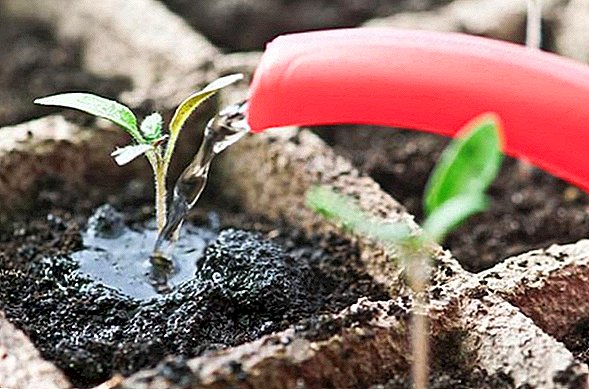 This is especially true at low temperatures outside: after watering, condensate forms on the film in the form of a thin layer of water, which reduces heat transfer. After 20-24 hours from the moment of watering, the greenhouse must be aired.
This is especially true at low temperatures outside: after watering, condensate forms on the film in the form of a thin layer of water, which reduces heat transfer. After 20-24 hours from the moment of watering, the greenhouse must be aired. - Illumination. The variety is heat-loving, so on cloudy days (especially if the sun is hidden behind the clouds for more than one day), it is necessary to resort to artificial lighting.
- The soil. The optimal soil for tomato is loose, with a lot of humus, medium acidity and mixed (with the addition of sand and perlite).
We advise you to read about what types of soil exist, how to improve soil fertility, how to independently determine the acidity of the soil at the site, as well as how to deoxidize the soil.
Remember: in the greenhouse the soil quickly "impoverishes" and "grows old", so the top layer of soil, if necessary, will need to be replaced with a new one. - Feeding. Potassium, phosphorus and nitrogen are the main elements that the tomato urgently needs during the vegetative period. Without these substances, the root system will not be able to develop well, and the plant itself will have phosphorus starvation (the appearance of red-purple spots on the leaves).
 The first additional feeding is made at the planting stage, the next - 30 days after the planting (provided that the top soil in the greenhouse has not been replaced).
The first additional feeding is made at the planting stage, the next - 30 days after the planting (provided that the top soil in the greenhouse has not been replaced).
Remember: fertilization does not always have the same effect: sometimes the growth of the plant itself increases, sometimes flowering and the appearance of the ovary accelerate. However, this variety needs at least two organic supplements during the growth period: it nourishes the tomato with the necessary minerals and strengthens its immunity to various diseases.
Seed preparation and planting
Prepare the seeds for planting in advance - at the end of February. Directly seed preparation contains the following steps:
- Rejection. The best harvest is obtained from large, heavy grains, so small and light seeds are poorly suited for planting. To separate the heavy seeds from the lungs, the following method is used: the seeds sink into the sodium chloride solution - the heavier ones remain at the bottom, while the lungs float.
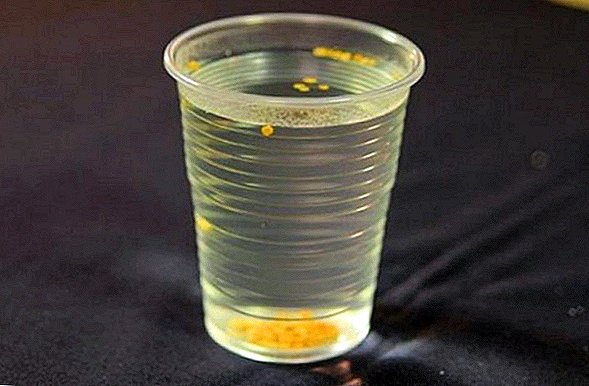
Did you know? The name "tomato" comes from Italy - literally translated as "golden apple". But the "tomato" - the Aztec name of the plant. Today, both of these names are absolutely equivalent and are used to refer to both the vegetable itself and its fruit.
- Warming up If the seeds were stored in a cold or damp room, this procedure must be carried out. Seeds are placed in small fabric bags and warmed up either under special heating lamps or on the battery for 2-3 days.
- Disinfection. Prevents the emergence and development of many diseases. The most traditional way is to hold seeds for 20-25 minutes in a weak (1%) solution of potassium permanganate.

- Treatment. To increase the yield, the seeds are soaked for 24 hours in a nutrient solution just before planting. It can be as folk remedies (aloe juice, potatoes, etc.), and special preparations ("Epin", sodium humate, etc.).
- Soak. Seeds are placed in gauze fabric, wrapped and lowered into warm (at least +25 ° C) water. The procedure itself lasts no more than 12 hours, while the water as it cools needs to be changed.
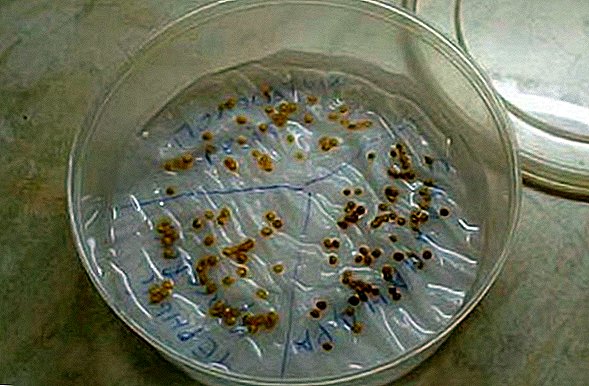
- Hardening. To improve immunity and reduce susceptibility to disease, the seeds need to be hardened. This is achieved by exposure to different temperatures: first, for 12 hours, the already sunflower seeds are placed in a refrigerator, then heated for 12 hours at +20 ° C. For successful tempering, the procedure must be repeated 2-3 times.

It is not necessary to carry out all the above procedures - however, if you complete 2-3 items from this list, the yield and immunity of the plant will increase significantly.
The technology for planting prepared seeds is as follows:
- Soil preparation. Pour moist soil into small cups, compact and slightly fertilize with any growth stimulant (1 g of substance per 1 liter of warm water). Then in the center of the ground two recesses are made, in each of which 1 tomato seed is placed. On top of the seeds are covered with moist soil (the top layer should not be more than 1 cm thick).
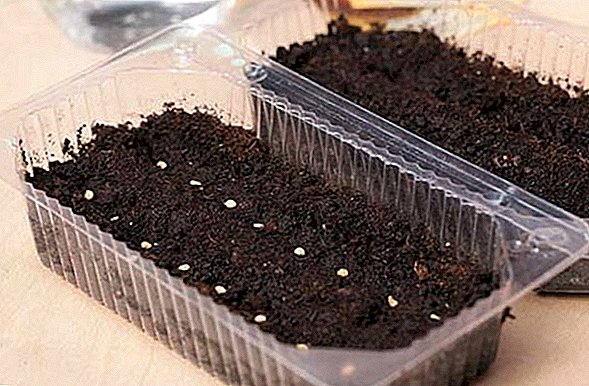
- Growing up. Cups with seeded seeds are placed in a warm (at least +25 ° C) place. From above the containers must be covered with a film - a mini-greenhouse is created. During this period, before the emergence of shoots, you need to monitor the soil moisture and periodically spray the soil. After the first shoots appear (after 6-7 days), the film is removed - now the seedlings will grow and grow stronger until they are ready to be transplanted into the main greenhouse (at least 14 days after the shoots).

Important! Optimum temperature and humidity are the two main components of a successful ovary and the formation of fruits. When the temperature is too high or low, the seedlings will die, and if the humidity is too high, the ovary cannot form: the pollen of the flower becomes too sticky and does not fall on the pistil - as a result, the flowers fall off, and the fruit is not tied.
Maintenance and care
After the seedlings have grown, grown and transplanted into the main greenhouse, it is time for such procedures:
- Care of seedlings. In the first 18-20 days from the moment of landing in the main ground, shoots grow slowly - this is the time for the first bait. It is best to use organic fertilizer, such as "green tea". It is done simply: for 50 l of water you need to take 4-5 kg of finely chopped grass (any), as well as add ash and liquid mullein - for each bush you need to pour about 1.5 l of such "tea".
Video: care for tomato seedlings
- Loosening the soil. Hammered and dense soil is the main enemy of seedlings: this kind of soil does not pass air and water to the roots badly. At least once a week, the ground around the seedlings must be loosened: act carefully so as not to damage the roots.
- Watering. Water for irrigation must be warm or at least room temperature (at least +18 ° C). It is better to water young saplings directly under the root to prevent leafs from rotting. The frequency of irrigation depends on the weather conditions and the temperature in the greenhouse, but on average it is carried out every 4-5 days (do not forget about the ventilation mode - described in detail above).
- Temperature. After the temperature of the air on the street is stable and stably reaches +20 ° C, in the daytime you can remove the film in the greenhouse - the sun's rays and warm air will be the best accelerators of the growth of bushes. Remember that warm but not hot air is required for this variety, so the temperature should always be kept within + 15-25 ° C.
- Masking This process is the removal of secondary stepsons (shoots of the main stem), which take nutrients from the plant.
We recommend to read about how to properly pinch tomatoes in the greenhouse and open ground.
 This procedure is done to increase the size of the fruit, thinning the beds and reduce the risk of fungal diseases. Pasoning is done after the first, most powerful and sturdy stepson has developed. All other stepchildren that are formed below the main one should be removed. Scions can be cut or ripped by hand - in the latter case, the stepsons should be broken off to the side. It is necessary to carry out the procedure every 10-14 days. It is best to conduct pinching on a sunny day - in the absence of sunlight, it is best to dust the places of the breakdown with ashes (this will prevent their rotting and infection).
This procedure is done to increase the size of the fruit, thinning the beds and reduce the risk of fungal diseases. Pasoning is done after the first, most powerful and sturdy stepson has developed. All other stepchildren that are formed below the main one should be removed. Scions can be cut or ripped by hand - in the latter case, the stepsons should be broken off to the side. It is necessary to carry out the procedure every 10-14 days. It is best to conduct pinching on a sunny day - in the absence of sunlight, it is best to dust the places of the breakdown with ashes (this will prevent their rotting and infection). - Garter. Due to the fact that the variety Love Earth is large and heavy, the tomato needs a garter.
It will be interesting for you to read about how and why to tie up tomatoes in open ground and in a polycarbonate greenhouse.
Usually tying is carried out after the appearance of the first fruits - the procedure eliminates the possibility of rotting and deformation of the fruit that lies on the ground. For tying, wooden pegs and garter fabric will be needed.Video: garter and paschkovanie tomato It is important to use a soft tissue that would not damage the delicate and fragile stem of the tomato. Суть процедуры проста: с помощью ткани стебель растения подвязывается к деревянному колышку - это создает дополнительную опору, и небольшой кустик уже не будет гнуться и ломаться под тяжестью созревающих плодов.
All of these stages are the main points for the care of tomato, but important are the timely protection and prevention of diseases.
Disease and pest prevention
Unfortunately, tomatoes are the kind of vegetable that is damaged by so many diseases and pests. Below we consider the most common greenhouse disease varieties and methods of dealing with them.
- Mosaic. Deformation of the leaves, changing their color, wilting of the plant itself and wrinkling of the fetus are the main signs of the disease. Low yield is also characteristic. To completely get rid of the virus, unfortunately, the plant only needs to burn. But the prevention of such a disease is soaking the seeds before planting in a solution of manganese, as well as spraying the plant itself with milk. The recipe is as follows: for 10 liters of water, add 1 l of milk and 1 tsp. urea. Sprayed means seedlings need every 3-4 days.

- Late blight. A fungus that affects the entire plant: leaves turn black, spots on the stem and fruits appear, and a powdery deposit occurs. When at least one of the listed symptoms appears, the whole plant should be treated with a fungicidal agent. Such drugs as "Ridomil Gold", "Acrobat", "Thanos" have recommended themselves well. As a folk remedy, use a solution of salt - to dissolve 10 g of salt in 1 liter of water. This means sprayed the whole plant every 2-3 days, until the signs of the disease are eliminated.

- Leaf mold. It affects the leaf part of the tomato - brown spots appear on the leaf, sometimes with a gray bloom (most often spots are formed on the lower part of the leaf). As the disease progresses, the leaves fall off and the plant dies. The main reason for the appearance of such a mold is excessive soil moistening - this proves once again the importance of airing the greenhouse. A method of dealing with this disease is a solution of copper oxychloride (35 g per 10 liters of water). This means the plant is sprayed every 2 days. Another way is to replace the upper part of the soil with a new one - this will speed up the recovery of the tomato.

- Blackleg. Basically, it affects young seedlings of tomato - the roots of the plant turn black and dry. For the treatment and prevention of seedlings need to spray a solution of calcium nitrate with a mixture of onion peel in the following proportions: 2 g of saltpeter, 100 g of husk decoction per 10 liters of water.

Read more about how to deal with dangerous diseases and pests of tomatoes.
Among the pests precipitating tomatoes, the main ones are:
- Whitefly. A small, up to 3 cm, insect that precipitates the lower part of the leaf. A sign of damage is the presence of wax on the entire surface of the sheet. The whitefly not only feeds on tomato juice, depleting the plant, but also spreads viral diseases. As a fight against whitefly, both proven preparations (Pegasus, Konfidor, etc.) and folk remedies are used - in particular, garlic tincture (100 g of grated garlic per 1 liter of water).
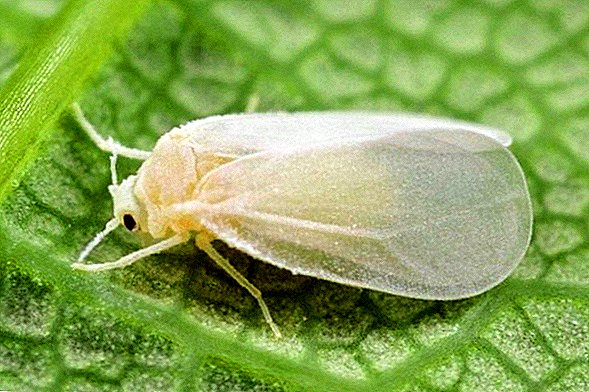
- Colorado beetle. The most common pest of tomatoes. Destroys a plant by eating leaves, stalks and even the fruits of a plant. A feature of the Colorado potato beetle is its adaptability to almost all chemicals - therefore, to combat it requires a complex effect.
Learn how to deal with the Colorado potato beetle folk methods.
One of the ways, in addition to baiting beetles with poisons, is breeding guinea fowls - these birds readily eat striped pests and, moreover, are the only birds that can digest the solid chitinous armor of the beetle. To prevent the emergence of the Colorado potato beetle will help planting between rows of saplings of garlic, marigold and marigold.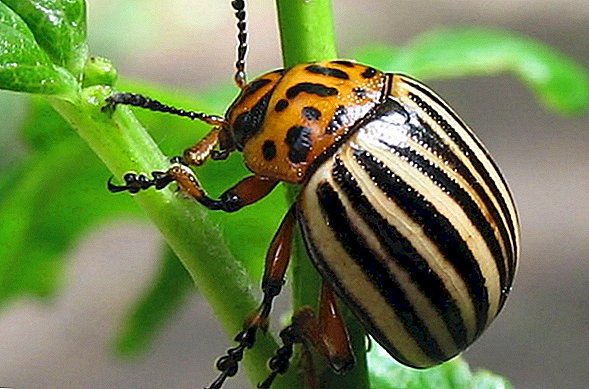
- Medvedka. The pest of potatoes and tomatoes damages not only shoots, stalks and fruits, but also just planted seeds. To fight with Medvedka, egg shells, soaked in sunflower oil, are introduced into the ground - such a “delicacy” is detrimental to the bear.

- Bare slugs. The pest is like a snail without a shell and leads mainly nocturnal. It affects leaves with mucus, and also eats fruits and stems. The best way to fight against them is to limit their access to a tomato: sawdust, red pepper, spruce needles and eggshell are scattered around the plant - such sharp or burning components injure the tender belly of slugs and the pest retreats.

- Garden scoop. The moth, which is not averse to feasting on fresh tomato leaves, is the same as its caterpillar. It is possible to use traditional insecticides to fight the scoop only before the fruits appear - otherwise it will be dangerous to eat the crop. As a preventative measure, weed removal from the plot and deep soil treatment before planting seedlings will help.

Of course, the pests of tomatoes are much larger, and it is not always easy to fight them. However, to preserve the integrity of the plant and high yields, pest and disease control must be carried out very carefully.
Did you know? Peru is considered the birthplace of tomatoes - the inhabitants of this country before the Europeans began to grow this culture. In Europe, tomatoes were considered poisonous for a long time: they were bred only as ornamental plants.
Harvesting and storage
Harvest varieties of tomatoes Earthly love can be obtained already 95-100 days after planting: fully formed, juicy and strong fruits are formed on the bush. Harvesting is important not to delay: if you overdo the fruit, it will become soft, begin to rot and will be unsuitable for transportation and eating.
You can pluck the fruit green: the ripening of this variety will occur within one month. However, due to the fact that the variety is early ripening, the tomatoes are cut off, as a rule, fully ripened: unlike other varieties, fully ripened tomatoes of this variety are well transported, do not crack and do not rot.  The collected fruits should be stored at a temperature not higher than + 14-16 ° С in a well-ventilated place (it is important to ensure that the harvested crop has free access of air so that the tomatoes do not rot). Do not forget to periodically sort out the harvest: if rot appears on any fruit, it will quickly spread to others.
The collected fruits should be stored at a temperature not higher than + 14-16 ° С in a well-ventilated place (it is important to ensure that the harvested crop has free access of air so that the tomatoes do not rot). Do not forget to periodically sort out the harvest: if rot appears on any fruit, it will quickly spread to others.
It will be helpful for you to read about how and where to store tomatoes, and why you cannot keep tomatoes in the refrigerator.
Remember that the longer tomatoes are stored, the more susceptible they become to harmful microorganisms. Some gardeners practice freezing ripe tomatoes in freezers: this allows you to preserve the freshness of the crop longer, but somewhat reduces its taste.
We reviewed the main points of cultivation, care and protection from diseases and pests of early ripe varieties of tomatoes Earthly love.  High-quality selection of seeds, compliance with the rules of planting, adhering to optimal temperature conditions, humidity, lighting and time for feeding make it possible to grow tasty, juicy fruits that will delight gardeners with an abundance of harvest in early summer.
High-quality selection of seeds, compliance with the rules of planting, adhering to optimal temperature conditions, humidity, lighting and time for feeding make it possible to grow tasty, juicy fruits that will delight gardeners with an abundance of harvest in early summer.


 It is very important to take into account when growing tomatoes: severe overheating is just as destructive for them as frost, so on hot days it is necessary to ventilate the greenhouse by briefly removing the film. The polyethylene film cover is characterized by high permeability to heat rays, so at night in the greenhouses there is a strong decrease in temperature - at night the difference with the figures in the street is no more than 2 degrees. Therefore, at particularly low temperatures, the greenhouse is additionally covered with burlap, cloth, or thick paper.
It is very important to take into account when growing tomatoes: severe overheating is just as destructive for them as frost, so on hot days it is necessary to ventilate the greenhouse by briefly removing the film. The polyethylene film cover is characterized by high permeability to heat rays, so at night in the greenhouses there is a strong decrease in temperature - at night the difference with the figures in the street is no more than 2 degrees. Therefore, at particularly low temperatures, the greenhouse is additionally covered with burlap, cloth, or thick paper. This is especially true at low temperatures outside: after watering, condensate forms on the film in the form of a thin layer of water, which reduces heat transfer. After 20-24 hours from the moment of watering, the greenhouse must be aired.
This is especially true at low temperatures outside: after watering, condensate forms on the film in the form of a thin layer of water, which reduces heat transfer. After 20-24 hours from the moment of watering, the greenhouse must be aired. The first additional feeding is made at the planting stage, the next - 30 days after the planting (provided that the top soil in the greenhouse has not been replaced).
The first additional feeding is made at the planting stage, the next - 30 days after the planting (provided that the top soil in the greenhouse has not been replaced).





 This procedure is done to increase the size of the fruit, thinning the beds and reduce the risk of fungal diseases. Pasoning is done after the first, most powerful and sturdy stepson has developed. All other stepchildren that are formed below the main one should be removed. Scions can be cut or ripped by hand - in the latter case, the stepsons should be broken off to the side. It is necessary to carry out the procedure every 10-14 days. It is best to conduct pinching on a sunny day - in the absence of sunlight, it is best to dust the places of the breakdown with ashes (this will prevent their rotting and infection).
This procedure is done to increase the size of the fruit, thinning the beds and reduce the risk of fungal diseases. Pasoning is done after the first, most powerful and sturdy stepson has developed. All other stepchildren that are formed below the main one should be removed. Scions can be cut or ripped by hand - in the latter case, the stepsons should be broken off to the side. It is necessary to carry out the procedure every 10-14 days. It is best to conduct pinching on a sunny day - in the absence of sunlight, it is best to dust the places of the breakdown with ashes (this will prevent their rotting and infection).







